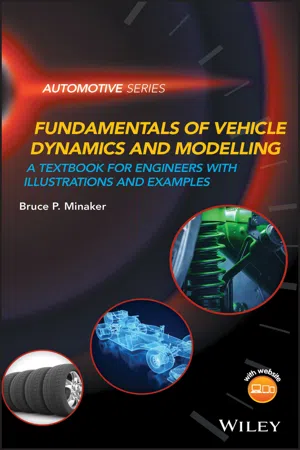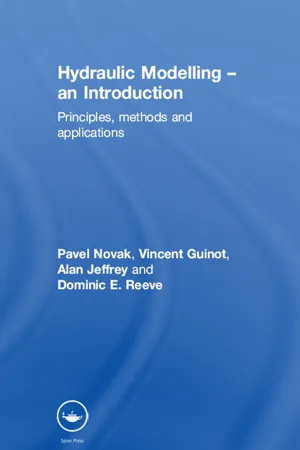Differential Equations
Differential equations are mathematical equations that describe how a quantity changes as a function of its own value and other variables. They are used to model a wide range of phenomena in science and engineering, from population growth to the behavior of electrical circuits. Solving differential equations involves finding a function that satisfies the equation and often requires advanced mathematical techniques.
6 Key excerpts on "Differential Equations"
- eBook - ePub
Fundamentals of Vehicle Dynamics and Modelling
A Textbook for Engineers With Illustrations and Examples
- Bruce P. Minaker(Author)
- 2019(Publication Date)
- Wiley(Publisher)
...Unfortunately, the number of operations required to find the solution grows very rapidly with an increase in the number of equations. As such, usually the sheer volume of calculations required dictates that a computer solver will be the pragmatic choice for systems with more than five or six equations. In the event of very large systems, e.g. tens of thousands of equations or more, there are also methods based on recursion, such as Gauss–Seidel, that often deliver an equally accurate solution, but with fewer operations. 7.2 Differential Equations A differential equation is one in which the rate of change of some value is related to the value itself. Differential Equations are further classified as partial Differential Equations (PDEs), or ordinary Differential Equations (ODEs). In a partial differential equation, there are multiple independent variables; frequently these are the coordinates in physical space. In an ordinary differential equation, there is only one independent variable, which is often time. Both may have many dependent variables. Partial Differential Equations, which are generally significantly more challenging to solve, are outside the scope of this text and will not be discussed here. Ordinary Differential Equations, however, are central, and will be further explained. The most general form of a set of ODEs, sometimes referred to as the implicit form, is written as: (7.5) Here the function may be such that the terms cannot be isolated from the rest of the equation. However, implicit ODEs are not particularly common when dealing with problems involving the motion of mechanical systems, and usually, they will be expressed in standard or explicit first order form : (7.6) The function is often referred to as the forcing function...
- F. Xavier Malcata(Author)
- 2020(Publication Date)
- Wiley(Publisher)
...15 Solution of Differential Equations Any equation containing differential coefficients is termed differential equation. Such equations can be divided into two major types – ordinary and partial; said classification depends on whether they encompass algebraic operations, lumped in f, on a single independent variable – and thus only ordinary derivatives appear as coefficients, i.e. f { x, y, dy / dx, d 2 y / dx 2, … } = 0, or more than one independent variable – so partial derivatives play the role of independent coefficients, e.g. f { x, y, z, ∂z / ∂x, ∂z / ∂y, ∂ 2 z / ∂x 2, ∂ 2 z / ∂x∂y, ∂ 2 z / ∂y 2, …} = 0 in the bivariate case. When a differential equation contains no terms on its independent variable(s) only, it is said to be homogeneous – otherwise it is labeled as nonhomogeneous; solutions for the latter may often be obtained using the corresponding homogeneous solution as template. The order of a differential equation is the order of the highest differential coefficient contained therein; the degree of a differential equation is the power to which the highest order differential coefficient is raised when the equation is rationalized (i.e. following removal of fractional powers). The general solution of a typical partial differential equation is a combination of arbitrary functions of specific arguments; their exact form is to be determined by application of boundary (and/or initial) conditions – dependent on the nature of the system/process under scrutiny. Conversely, the general solution of an ordinary differential equation contains as many specific independent functions (each one multiplied by an arbitrary constant) as its order. The most common methods of analytical solution, via integration, will be reviewed below. 15.1 Ordinary Differential Equations A differential equation is said to be linear when it is linear in the dependent variable and its derivatives – otherwise it is said to be nonlinear...
- eBook - ePub
- Arsen Melkumian(Author)
- 2012(Publication Date)
- Routledge(Publisher)
...12 Difference and Differential Equations Many economic processes demonstrate dynamic behavior. However, in some of these cases, the underlying system is guided by rather simple relationships between quantities and their rates of change. Whenever we have a relationship between functions and their derivatives or rates of change, we essentially deal with differential or difference equations. For functions of continuous variables, we consider Differential Equations. For quantities dependent on a discrete variable, we talk about difference equations. Consider an economic process developing in time. Most likely the functions involved in the process will depend on their previous values. For instance, the current supply depends on the demand we observed a week, a month or a year ago. Whenever we have a relationship involving quantities at time t and their previous values at times t − 1, t − 2, and so on, we implicitly deal with a mathematical structure known as a difference equation. This chapter begins with the mathematical theory of such equations, considers some applications of difference equations to economic problems, and closes with Differential Equations. 12.1 Difference equations 12.1.1 Linear first-order difference equations A linear first-order difference equation may be written as follows: where For example, the equation is a linear first-order difference equation. Alternatively, the first-order difference equation in (12.1) may be written in the form: If and are constants, then we can write equation (12.3) as follows: where b and c are some constants. The difference equation is known as a first-order difference equation with constant coefficients...
- eBook - ePub
Ultra Wideband Antennas
Design, Methodologies, and Performance
- Giselle M. Galvan-Tejada, Marco Antonio Peyrot-Solis, Hildeberto Jardón Aguilar(Authors)
- 2017(Publication Date)
- CRC Press(Publisher)
...Appendix B Some Concepts Related to Differential Equations Contents B.1 Generalities B.2 Order B.3 Differential Equation Systems B.4 Initial and Boundary Value Conditions B.5 Existence and Uniqueness B.1 Generalities Differential Equations are used to model the variation of one quantity as a function of another one (or more than one). When the differential equation presents one or more variables which depend on only one parameter, it is said it is an ordinary differential equation, otherwise we are addressing partial Differential Equations. For example, m d 2 x d t 2 = F (B.1) ∂ 2 u ∂ x 2 + ∂ 2 u ∂ y 2 = 0 (B.2) In the case of Equation (B.1), Newton’s law for the position x (t) of a particle acted on by a force F, we can see how there is a variation of the distance, x, as a function of time, t (i.e., a velocity), and there is not any other independent variable. Hence this equation is an example of an ordinary differential equation. On the other hand, Equation (B.2), corresponding to the Laplace’s or the potential equation, presents the potential u as a function of two spatial variables, which means that u = u (x, y) and therefore it is a partial differential equation. B.2 Order The order of an ordinary or partial differential equation is the order of the highest derivative that appears in the equation. Thus, for example Equation (B.1) is a second order ordinary equation. B.3 Differential Equation Systems When a problem is described by more than one differential equation (either ordinary or partial and of any order), it is said that we have a system of Differential Equations. A classical example is the set of partial Differential Equations formulated by Maxwell and presented in Chapter 9 : ∇ × E + μ 0 ∂ H ∂ t = 0 (B.3) ∇ × H − ε 0 ∂ E ∂ t = J (B.4) ∇ ⋅ ε 0 E = ρ (B.5) ∇ ⋅ μ 0 H = 0 (B.6) where E represents the electrical field, H the magnetic field, ε 0 is the permittivity of vacuum, and µ 0 is the permeability of vacuum...
- eBook - ePub
Hydraulic Modelling: An Introduction
Principles, Methods and Applications
- Pavel Novak, Vincent Guinot, Alan Jeffrey, Dominic E. Reeve(Authors)
- 2018(Publication Date)
- CRC Press(Publisher)
...Chapter 2 Theoretical background – mathematics 2.1 Ordinary Differential Equations 2.1.1 Definitions Physical situations described by quantities that vary continuously with respect to their position in space and possibly with time can usually be described in terms of systems of partial Differential Equations (PDEs). These are equations that relate the quantities involved to some of their derivatives with respect to space variables and time. In the simplest case, when only a single quantity u (t) depending on a variable t is involved, the variation of u (t) with respect to t is described by an ordinary differential equation (ODE) that relates u (t) to some of its derivatives. If the highest order derivative involved in an ODE is d n u /d t n, the ODE is said to be of the nth order. The variable t is called the independent variable, and in physical situations t is often the time, while the quantity u (t) is called the dependent variable because its value depends on t. A general nth-order ODE can be written symbolically as F (t, u, u ′, u ″, … u (n)) = 0, (2.1) where u ′ = d u d t, u ″ = d 2 u d t 2 =, …, u (n) = d n u d t n, and F is an arbitrary function of its n + 1 arguments t, u, u′, u″, …,u (n). The form of equation (2.1) is too general to be of use when discussing ODEs, so in practice it is necessary to restrict study to some of the most frequently occurring types of ODE that arise in applications. This involves considering special forms that may be taken by the function F, although only the most important of these will be mentioned here. The simplest type of ODE is of the form d y / d t = g (y) h (t), where g (y) and h (t) are functions of their respective arguments. An ODE of this type is said to have separable variables, because it can be written as ∫ (1 g (y)) d y = ∫ h (t) d t, in which the variables y and t have been separated, after which the general solution follows by integration...
- Bernard Liengme(Author)
- 2008(Publication Date)
- Academic Press(Publisher)
...Chapter 14 Differential Equations Publisher Summary Differential Equations occur in many physical problems. This chapter opens up with the explanation of some of these problems. To solve dy/dx =f(x,y) over the x range [a, b], the value is needed to know of y(a), which is called the initial value. Problems of this type are called initial value problems. With second-order Differential Equations two integration constants arise. For an initial value problem one needs to know the initial value of the two values of the dependent variables. Alternatively, the problem may be defined by specifying some conditions at one value of x and others at another value of x. Such problems are called boundary value problems. The chapter describes Euler’s method to solve initial value problems. It also takes into account the Runge-Kutta method. Differential Equations occur in many physical problems. Let us look at some simple examples. (i) A body falling through the air is subjected to two forces: gravity acting downward and air resistance acting upward. The first force is constant, but the second is proportional to the body's velocity. This gives rise to the first-order differential equation (14.1) (ii) Consider the chemical reaction A + B → C where the rate of reaction is proportional to the concentration of A and to the concentration of B. Let x be the amount of A and B reacted at time t, and let the initial concentration of A and B be a and b, respectively. These quantities will be related by (14.2) (iii) The equation of motion for a harmonic oscillator is (14.3) Equations 14.1 and 14.2 are examples of first-order Differential Equations, while Equation 14.3 is of second order. The equations in these examples may readily be solved by analytical means...





